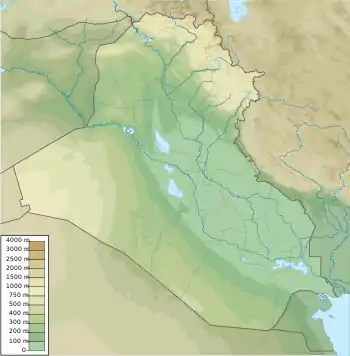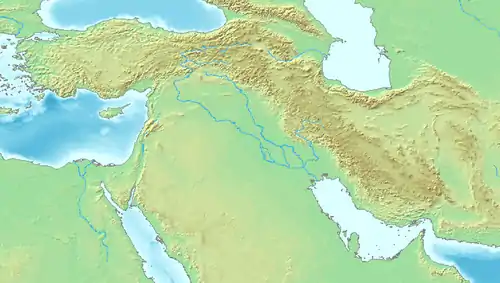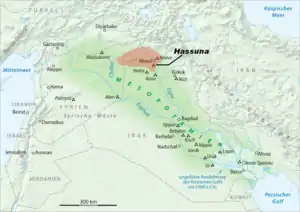Tell Maghzaliyah
Tell Maghzaliyah (Tell Maghzalia) is a prehistoric aceramic Mesolithic and Neolithic site located approximately 7.5 km northwest of Yarim Tepe, with which it shows some similarities. Tell Maghzaliyah shows the development of pre-Hassuna culture. There are also numerous connections to the Jarmo culture going back to 7000 BCE.
 Shown within Iraq  Tell Maghzaliyah (Near East) | |
| Alternative name | Magzalia, Tell Magzalia |
|---|---|
| Location | Nineveh Governorate, Iraq |
| Coordinates | 36°22′48″N 42°26′24″E |
| Type | tell, archaeological site |
| History | |
| Periods | Pre-Pottery Neolithic B |
| Site notes | |
| Excavation dates | 1977–1980 |
| Archaeologists | Nikolay Bader |

Location
The site is situated near the Abra River, a tributary of the Habur River, which eventually drains into the Euphrates River. The site was excavated in the 1970s and 1980s by Soviet archeologists, most notably N.O. Bader. Its discovery was recorded in the spring of 1977.
The site is approximately 4500 square meters in area, and the depth of deposit is approximately 8 meters.
The original village housed approximately 150 people. It was more suited to hunting and gathering, than to long-standing agriculture. Archeological evidence includes flint flakes and debitage, along with evidence of semi-permanent settlement, including houses and utilitarian structures. Permanent settlement remains indicate pisé walls and stone foundations. The clay used for construction was apparently imported from other locations, as the primary natural stratigraphy is limestone loam.
The excavators estimated a total of 15 building levels at the site, each with an average thickness of 50–60 cm. The assemblage suggests a tightly packed settlement, occupied continuously over its existence.
Early metallurgy
A hammered copper ‘awl’ (or a chisel) was found on the floor of one of the houses.[1][2]
Other early sites with metal are also Ali Kosh in lowland Iran, and Tol-e Nurabad and Tepe Sialk in the Iranian Zagros Mountains. Also in the Iranian Zagros, near Marvdasht, are located the sites of Tall-i Mushki, and Tall-i Jari showing evidence of early metallurgy. All these settlements date to the late 7th/early 6th millennia BC.[2]
See also
References
- CHARLES KEITH MAISELS (1999). EARLY CIVILIZATIONS OF THE OLD WORLD;THE FORMATIVE HISTORIES OF EGYPT, THE LEVANT, MESOPOTAMIA, INDIA AND CHINA. ABINGDON: ROUTLEDGE. ISBN 1-134-83731-3. OCLC 1199128027.
- Potts, Daniel T., ed. (15 August 2012). "Northern Mesopotamia". A Companion to the Archaeology of the Ancient Near East. Vol. 1. John Wiley & Sons, 2012. p. 296. ISBN 978-1-4443-6077-6.
Further reading
- "Tell Maghzaliyah: an early Neolithic site in northern Iraq"; Soviet Archeology; 1979:117-32
- Voronezh State Pedagogical University; Kornienko, Tatiana V. (2020). "Tell Maghzalia in the context of the early Neolithic sites of Northern Mesopotamia and neighbouring territories". Rossiiskaia arkheologiia (4): 5–20. doi:10.31857/S086960630012626-7.
- Early stages in the evolution of Mesopotamian civilization : Soviet excavations in northern Iraq. Norman Yoffee, Jeffery J. Clark. Tucson, Arizona. 2016. ISBN 0-8165-3281-8. OCLC 930303471.
{{cite book}}: CS1 maint: others (link)